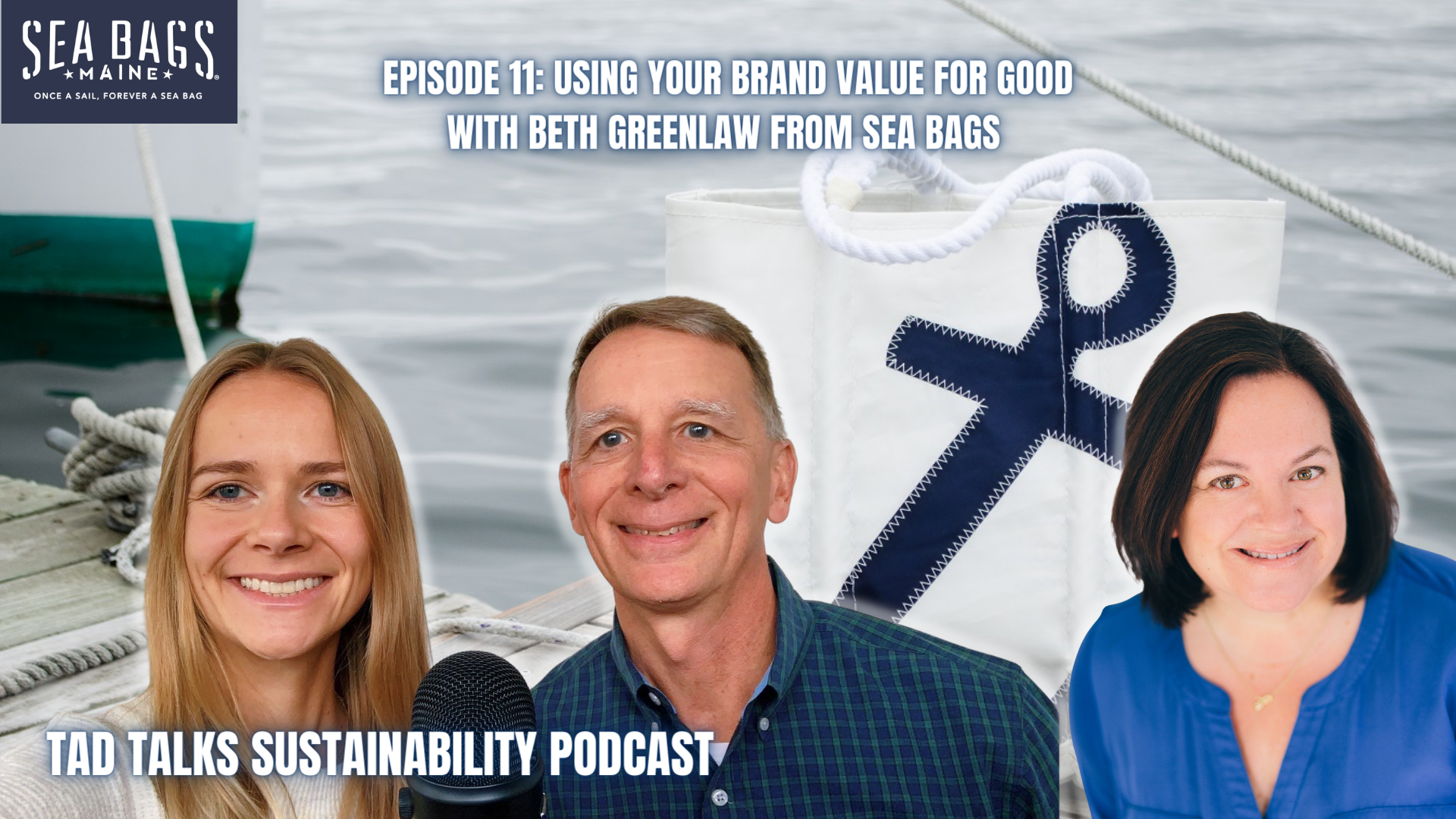Episode 11: Giving Sails a Second Life: The Value of Recycled Content Certification with Beth Greenlaw from Sea Bags
Click the links below to listen to the full episode
Utilizing recycled content in your products not only makes your product more sustainable, it also reduces waste. In this episode, Tad and Julianna sit down with Beth Greenlaw, President and Chief Sustainability Officer at Sea Bags, to discuss Sea Bags’ origin story, the rewards and challenges of sourcing materials locally, how using recycled sails has diverted a major waste stream from landfill, why Sea Bags decided to pursue GreenCircle Recycled Content certification, and what’s next for Sea Bags.
from a sustainability perspective, importing materials from other countries has a huge carbon footprint. why is it so important to you to source your materials from the United States? What challenges does this present?
“I will answer your second question first. I think the challenges have really turned into benefits for us, particularly in the last year, as we see a huge supply chain crisis. Everything is bottleneck if it's coming from overseas right now, and we are so lucky to be able to say that we can kind of control our own destiny. We control our supply chain for the most part. Not to say we haven't had a few glitches, but none like we're seeing everywhere else. So the obstacles are opportunities for us and that part's been really nice for us this year. We are open to doing business overseas for sure, but we like to support, our own communities and our own businesses first. We like to create jobs here.
Having said that, we're working with one of the largest sales suppliers to get rid of their used sales and we're taking in a shipment from Europe. This is going on as we speak, and I'm extremely proud of this. The first thing we said is ‘how can we get these sales here and make the smallest carbon footprint possible so that it still makes sense?’ It is always on our mind to do things the right way, but no one's ever done this before. So we're kind of just working our way through it with set goals along the way.”
You are diverting a major waste stream from landfill by giving these sails a second life. How many bags can you make out of one sail?
“There's not really easy answer because a couple of things determine when a sail is no longer sailable. One is the size of the sail and how much sailing people really do. If they're out there cruising and just having cocktails that sail is going to last a long time. If they're sailing competitively, through windy conditions, and if they're in an area that has a lot of sun, the sun will actually stretch the sail. So determining how many bags we can get from a sail really depends on just how much people sail and how hard they sail.
There are all different sizes of boats and sizes of sails, so we have become masters at utilizing as much of the sail to increase our yield as we can. The people that cut our sails are true masters at laying it out. When we look at the anatomy of a sail, we don't just look at how many large totes can we get. We trace it all out so that we get even the smallest pieces of scrap we use for hang tags and the corners we use to make rounds for our bucket bag. We utilize everything we can to reduce our own waste. I'm not worried about the supply chain running out, as you indicated, the economy's doing very well. People are investing in lifestyle activities, and as long as there are sailors, there will be sails. There is an evolution in the material, so we have to evolve our manufacturing and our design process to utilize everything that's out there, but we haven't scratched the surface.
We say that every bag has a story. It has a story of where the sail has been, and it has a story of the adventure that the bag will go on. It's really fun to think about, although I think there's a lot opportunity in our industry to go upstream and downstream to continue the work that we've started. So I'm really excited to be partnering with the sail makers to get rid of some of their waste. We've recently come together to say, ‘what can we do to kind of lead the industry on some of the parts of the sail that we're not able to recycle and find new homes for those?’ So there's plenty of work to be done beyond just making the bags, which I'm super proud of, but I'm really thrilled that we're all starting to align.
The other thing that's great is that now sailing in general, the races and the regattas, they're all looking for sustainability standards and what they can do to be better stewards to our earth. It started from the consumers and the end users, and they are kind of demanding sustainable practices.”
You recently achieved greencircle’s recycled content certification, what were the drivers behind your decision to pursue third-party certification?
“The validation of having a third-party certification has been very, very helpful to us. It's not enough anymore that we say we're doing this, we have to have a measurement and tool that consumers can rely on. Our GreenCircle certification has been the great first step for us in that process.
The industry and the consumers are headed that way. Everybody wants traceability, and everybody needs validation and authenticity. So we are super proud of the authenticity we have in our company and in our product, but we never wanted to be on the end of the question of, ‘are you really doing what you say you are?’ As we scale, and as our brand gets better known, people want to know, not just from us, but from a reliable source that, we do what we say we do. And the other reason why I chose GreenCircle is when I looked at the audit process, it drove us to better practices on how we manage our internal processes. So we made some really good changes internally that will allow us to better account for what we're doing. So it's been a good process and there's plenty of room for us to grow as we continue to grow with GreenCircle.
The other benefit that we've had from this is when we go to partner with larger brands that have a lot to lose if a consumer were to lose their trust in them. It's just been very easy for us when they say, ‘how do you validate your recycled content?’ We can provide the certificate and GreenCircle in and of itself, is respectful in how they do things. So it's been a very easy gateway for us to have that in our back pocket.
I think the biggest benefit we've had is changing some of our internal processes after the audit. It has just made us better and showed us how we can document better. Achieving GreenCircle certification wasn't easy by any means, it was definitely a pretty stringent process, which is why I chose GreenCircle because at the end I knew it was going to give us the authenticity we needed. It took some work to get there and I am extremely proud that we got through it as we did.”
MORE VIDEO CONTENT
ABOUT Beth Greenlaw
Beth Greenlaw is the President and Chief Sustainability Officer at Sea Bags - the Maine-based designer and manufacturer of bags, totes and accessories all made from recycled sail cloth. Greenlaw has been with Sea Bags since it incorporated in 2006. What started as just a few anchor totes on the working waterfront of Portland, Greenlaw and the Sea Bags team have grown the business to 39 retail stores across 14 states and have saved over 700 tons of sails from landfills while doing it. As Sea Bags continues to grow, Greenlaw remains focused on the core mission of the company: being sustainable in product and process, being an active member of the community and keeping production local.








